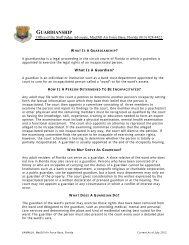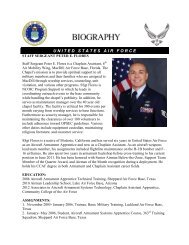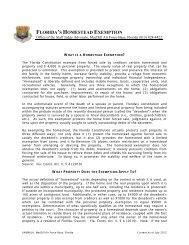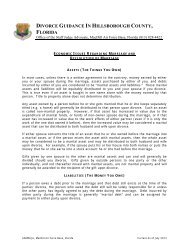6 AMW History - MacDill Air Force Base
6 AMW History - MacDill Air Force Base
6 AMW History - MacDill Air Force Base
Create successful ePaper yourself
Turn your PDF publications into a flip-book with our unique Google optimized e-Paper software.
<strong>History</strong> of the 6th<br />
1919 -- Present<br />
Above: Members of the 6th Composite<br />
Group stationed in Panama, circa 1927.<br />
Above: Crews of the 6th flew training<br />
missions at Dalhart Army <strong>Air</strong>field, Texas<br />
in 1944 as they prepared for the war in the<br />
Pacific. Many of these crews later flew<br />
bombing missions from the island Tinian.<br />
Below: The 6th painted their emblem<br />
on Charles Lindbergh’s plane,<br />
the Spirit of St. Louis, when he visited<br />
their base, France Field, Panama in 1928.<br />
The 6th <strong>Air</strong> Mobility Wing traces its roots indirectly back to the early years of<br />
American military aviation when its predecessor was organized in 1919. Initially<br />
named the 3rd Observation Group, the unit was re-designated as the 6th<br />
Composite Group in 1922 and assigned to France Field, Panama Canal Zone.<br />
From 1922 to 1936, the 6th Composite Group served as a<br />
headquarters unit for the defense of the Panama Canal Zone. Those<br />
early <strong>Air</strong>men flew patrol missions, conducted maneuvers, and<br />
participated in goodwill flights to Central and South America. The 6th<br />
evolved throughout its long and illustrious history, and along the way<br />
there were many changes to its name and mission.<br />
Towards the end of the 1930s, a major change in the group’s mission<br />
foreshadowed the future. In 1937, it was renamed the 6th Bombardment<br />
Group – the designation it carried into World War II. For most of the<br />
next 15 years, it carried that name in one form or another. The Group<br />
continued to operate in the Canal Zone until October 1943, when it<br />
inactivated because the demands of the American war effort required its<br />
presence elsewhere. After returning to the United States for training, the<br />
6th Bombardment Group relocated to North Field on the small island<br />
Tinian in the Pacific by the end of 1944. As part of the Twentieth <strong>Air</strong><br />
<strong>Force</strong>, planes carrying the 6th’s pirate emblem struck major targets in<br />
Japan and numerous kamikaze bases in the surrounding islands. The<br />
Group received two Distinguished Unit Citations for contributions in the<br />
campaigns against Japan that brought an end to World War II.<br />
After the war’s end, the Group eventually relocated to Kadena,<br />
Okinawa, where it deactivated in October 1948. The <strong>Air</strong> <strong>Force</strong> briefly<br />
brought it back from January 1951 to June 1952 before inactivating it<br />
again. This marked the end for the old 6th Bombardment Group. When<br />
it returned in 1985, the <strong>Air</strong> <strong>Force</strong> renamed it the 6th Operations Group.
6th <strong>Air</strong> Mobility Wing<br />
The 6th Wing (1951- Present)<br />
In the early 1950s, the Korean Conflict and the Cold War resurrected the need for aerial bombardment.<br />
Using the name of the old Group, the <strong>Air</strong> <strong>Force</strong> created a new unit, the 6th Bombardment Wing (Medium)<br />
and assigned it to Walker AFB, New Mexico. This new version of the 6th flew the formidable B-36<br />
“Peacemaker” and later the B-52 “Stratofortress” bombers. As the Soviet missile threat increased during<br />
the Cold War, so did the 6th Wing’s mission. From 1962-65, the newly re-designated 6th Strategic<br />
Aerospace Wing maintained an intercontinental ballistic missile (Atlas) squadron. However, Walker AFB<br />
closed in 1967, and the Wing moved without personnel or equipment to Eielson <strong>Air</strong> <strong>Force</strong> <strong>Base</strong>, Alaska.<br />
In Alaska, the 6th Strategic Wing – later the 6th Strategic Reconnaissance Wing until 1988 – flew<br />
reconnaissance missions with the state-of-the-art RC-135 aircraft. The Wing also flew aerial refueling<br />
assignments as part of the Alaskan Tanker Task <strong>Force</strong>, and supported numerous <strong>Air</strong> <strong>Force</strong> and Navy<br />
exercises. In addition, the Wing maintained a detachment at Shemya <strong>Air</strong> <strong>Force</strong> Station in the Aleutian<br />
Islands, and operated there from 1975-76 when Eielson closed for repair of earthquake damage.<br />
Left: The 6th Wing flew the RC-135E reconnaissance jets while stationed at Eielson <strong>Air</strong> <strong>Force</strong> <strong>Base</strong>, Alaska.<br />
Right: A Strategic <strong>Air</strong> Command patch, top, and an <strong>Air</strong> <strong>Force</strong> officer’s pilot wings pin worn at Walker AFB.<br />
In 1994, the 6th headed back south. Following the termination of the <strong>Air</strong> <strong>Force</strong>’s fighter mission at<br />
<strong>MacDill</strong> AFB, Florida in 1993, the 6th reactivated there as a base support wing in January 1994. This soon<br />
changed after <strong>MacDill</strong> played an important role in U.S. operations to restore democracy in Haiti in<br />
September that year. Congress called for the retention of the airfield and, as part of the deal, assigned an<br />
aerial refueling squadron to relocate to <strong>MacDill</strong>. The 6th now became an <strong>Air</strong> Refueling Wing. Five years<br />
later, the <strong>Air</strong> <strong>Force</strong> assigned another facet of air mobility to the Wing. In January 2001, the 6th <strong>Air</strong><br />
Mobility Wing began providing airlift and transport services to the combatant commanders stationed on<br />
base who played vital roles in the Global War on Terrorism. The new millennium brought even more<br />
changes. Efforts to streamline the Department of Defense in the late 1990s eventually led to a change in<br />
operations. As part of these changes, the <strong>Air</strong> <strong>Force</strong> Reserve’s 927th <strong>Air</strong> Refueling Wing relocated to<br />
<strong>MacDill</strong>. In 2008, they began joint operations with the 6th <strong>Air</strong> Mobility Wing. This new team showcased<br />
their abilities in January 2010, when both wings contributed significantly to <strong>Air</strong> <strong>Force</strong> relief operations that<br />
brought millions of pounds of supplies to Haiti and evacuated hundreds of critically injured patients.<br />
Current: 1 Oct 2012
















